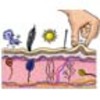

Introduction to Specieal Senses: All living things (including humans) use their senses to respond to everything around them. This protects us in case of danger and helps lead us to food and safety. But our senses do much more than that. They lead us through our daily lives. We see where we left our shoes, smell the toast cooking, taste our breakfast, feel the cool air, put on our coats and hear the school bus coming. We usually think of ourselves as having five senses; smell, taste, sight, hearing and touch. Yet only the first four are true special senses with special sensory receptor cells all found in the head. Touch is more generalized, with nerve endings all over our body in the skin. Skin sensors alert us to cold, heat, pressure and pain. These are very important for our protection. Just think how dangerous it would be if you didn't feel pain when you picked up a hot pan! Sensors tell us when our body needs to react for safety. All the senses bring their messages to our brain to interpret and tell us how to react. Some responses need to be so quick (like dropping a burning pan) that they are on a reflex loop in the spinal cord and never even make it to the brain to be thought about!
If you are not a subscriber, you can purchase a downloadable bundle on the Special Senses with reading, diagrams, activities, and assessment. If you are a subscriber, you can access this bundle (and others) with your teacher login HERE.






